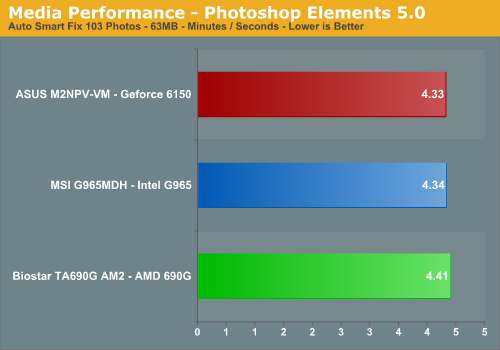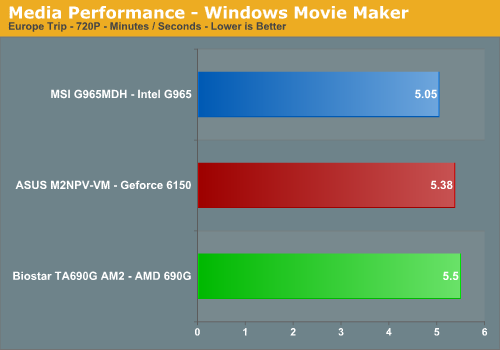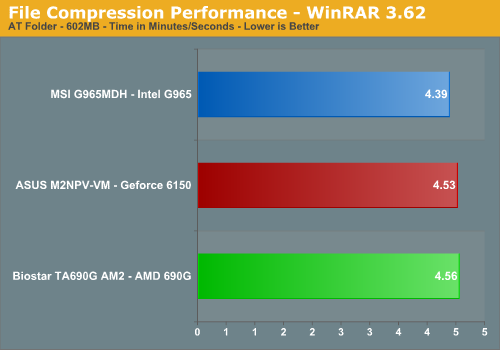Media Performance
We will take a brief look at general media performance with our test suite for that includes Adobe Photoshop CS3, Adobe Photoshop Elements 5.0, and Windows Movie Maker.
We utilize the widely available Retouch Artists Photoshop Speed Test for measuring platform performance in Adobe's Photoshop CS3. The benchmark applies a number of actions to a test image while we measure the total time elapsed during the active portion of the test. We set history states to 1, cache levels to 4, and CS3 was configured to make use of all available system memory. The scores reported include the full conversion process and is represented in minutes/seconds, with lower numbers providing better performance.

The results are once again interesting as we did not expect our AM2 systems to perform this well. Photoshop has favored the Intel Core 2 Duo greatly in the past and once again we are looking at a speed issue with the E6300 that allows the AM2 systems to be in the hunt.
Our next test is one recommended by Intel, but the test itself appears to be fair and results are very repeatable. This test simply measures the amount of time required to fix and optimize 103 different photos weighing in at 63MB. Time is measured in minutes and seconds, with lower times resulting in better performance:

This test not only stresses the CPU but also gives the storage systems a good workout. Our 6150 platform barely edges out the Intel platform in a test where sheer CPU speed can make up the difference in elegant design. That sounds so familiar, are we talking about the differences between Athlon 64 and P4 NetBurst or Intel Core 2 Duo and Athlon 64 X2? Either way you cut it, the 6150 once again finishes ahead of the 690G due to better storage system performance.
Next on the list is our Windows Movie Maker test that will meld our European vacation content (recorded off TV) into a newly downloadable file that can be viewed on our Xbox 360 in a pleasing 720p format. The values reported are in minutes/seconds for the conversion time, with lower numbers being better.

Our Intel platform has a significant advantage in this test with the 6150 scoring better than the 690G in a test that stresses both the CPU and storage system again. These results were interesting as previous testing with this application indicated our AM2 platform would be a little more competitive.
File Compression Performance
In order to save space on our hard drives and ensure we had another CPU crunching utility, we will be reporting our file compression results with the latest version of WinRAR that fully supports multi-treaded operations and should be of particular interest for those users with dual core or multi-processor systems. Our series of file compression tests utilizes WinRAR 3.62 to compress our test folder that contains 444 files, ten subfolders, and 602MB worth of data. All default settings are utilized in WinRAR along with our hard drive being defragmented before each test.

Our G965 platform basically zips away from our two AM2 platforms in this test that heavily stresses the CPU subsystem and at times the storage system. The Core 2 Duo has always excelled in this benchmark and once again shows its strength. We were surprised that our two AM2 platforms scored this well with the advantage going to the NVIDIA 6150 due to better storage system throughput in our opinion.
We will take a brief look at general media performance with our test suite for that includes Adobe Photoshop CS3, Adobe Photoshop Elements 5.0, and Windows Movie Maker.
We utilize the widely available Retouch Artists Photoshop Speed Test for measuring platform performance in Adobe's Photoshop CS3. The benchmark applies a number of actions to a test image while we measure the total time elapsed during the active portion of the test. We set history states to 1, cache levels to 4, and CS3 was configured to make use of all available system memory. The scores reported include the full conversion process and is represented in minutes/seconds, with lower numbers providing better performance.

The results are once again interesting as we did not expect our AM2 systems to perform this well. Photoshop has favored the Intel Core 2 Duo greatly in the past and once again we are looking at a speed issue with the E6300 that allows the AM2 systems to be in the hunt.
Our next test is one recommended by Intel, but the test itself appears to be fair and results are very repeatable. This test simply measures the amount of time required to fix and optimize 103 different photos weighing in at 63MB. Time is measured in minutes and seconds, with lower times resulting in better performance:

This test not only stresses the CPU but also gives the storage systems a good workout. Our 6150 platform barely edges out the Intel platform in a test where sheer CPU speed can make up the difference in elegant design. That sounds so familiar, are we talking about the differences between Athlon 64 and P4 NetBurst or Intel Core 2 Duo and Athlon 64 X2? Either way you cut it, the 6150 once again finishes ahead of the 690G due to better storage system performance.
Next on the list is our Windows Movie Maker test that will meld our European vacation content (recorded off TV) into a newly downloadable file that can be viewed on our Xbox 360 in a pleasing 720p format. The values reported are in minutes/seconds for the conversion time, with lower numbers being better.

Our Intel platform has a significant advantage in this test with the 6150 scoring better than the 690G in a test that stresses both the CPU and storage system again. These results were interesting as previous testing with this application indicated our AM2 platform would be a little more competitive.
File Compression Performance
In order to save space on our hard drives and ensure we had another CPU crunching utility, we will be reporting our file compression results with the latest version of WinRAR that fully supports multi-treaded operations and should be of particular interest for those users with dual core or multi-processor systems. Our series of file compression tests utilizes WinRAR 3.62 to compress our test folder that contains 444 files, ten subfolders, and 602MB worth of data. All default settings are utilized in WinRAR along with our hard drive being defragmented before each test.

Our G965 platform basically zips away from our two AM2 platforms in this test that heavily stresses the CPU subsystem and at times the storage system. The Core 2 Duo has always excelled in this benchmark and once again shows its strength. We were surprised that our two AM2 platforms scored this well with the advantage going to the NVIDIA 6150 due to better storage system throughput in our opinion.










70 Comments
View All Comments
chucky2 - Wednesday, March 7, 2007 - link
BlingBlingArsch of the AnandTech forums linked to some pictures of the board, and there's one of the back panel I/O: http://img256.imageshack.us/img256/5498/board234cx...">http://img256.imageshack.us/img256/5498/board234cx...Looks like there's definitely no Firewire... :( :( :(
What are these manufacturers thinking (or rather not thinking) not including Firewire on this boards? These would be totally complete solutions, especially this Abit with the optical out it has, if they'd only have Firewire on them...
...and the expansion is so limited, putting in an add-in Firewire basically kills for TV tuner, capture, etc. additions.
Man...talk about something that's almost perfect that gets ruined by either a poor design decision or a poor bean counter decision... :(
Chuck
Myrandex - Wednesday, March 7, 2007 - link
"The 6150 performs okay considering the age of its core and we will see the new 6150SE and older 6100 chipset performing a few percent better overall but not enough to catch the 690G."How would the 6100 be a few percent better when it is clocked lower?
Renoir - Tuesday, March 6, 2007 - link
The review over at http://www.bit-tech.net/hardware/2007/03/02/amd_69...">Bit-tech.netsays the 690G supports dual-link DVI and confirmed as much by sending 2560x1600 over DVI to the dell 30incher. This review however says "Larger 30" flat panel monitors won't be able to run at native resolution" and the technology overview article says "The digital outputs use TMDS transmitters that run at 165MHz". What's the deal?Gary Key - Wednesday, March 7, 2007 - link
The 690G supports Dual-Link DVI. We had stated this on page two but not in a separate section. I will reword the 2D paragraph to make this clear. As for the resolution, I am using a Samsung 30" panel and the current Vista drivers limit me to 2048x1536. I have sent a board to Jarred who has the Dell 30" to test on it. AMD still confirms that 2048x1536 is the "current" max resolution although we know the hardware has 2560x1600 capability according to one of our sources.Renoir - Wednesday, March 7, 2007 - link
Hmmm something's not quite right it seems. Can't see why they were able to send 2560x1600 if you couldn't. Would definitely appreciate Jarred checking it on the dell although I'd be surprised if it was a monitor issue. Who knows without trying. Have asked bit-tech what os they were using to get it to work. An XP vs Vista issue perhaps? The related paragraph in the technology overview article mentions the TMDS's run at 165mhz which I understand is single-link? Have seen the 165mhz listed elsewhere for the 690G so am curious where this info comes from if the chipset is dual-link? Unless I've misunderstood something about "165mhz"?Gary Key - Wednesday, March 7, 2007 - link
The DVI spec transmits data using the transition minimized differential signaling (TMDS) protocol. The DVI spec calls for each DVI output to have at least one TMDS “link” consisting of three data channels (RGB) and one control channel. The maximum speed at which a single 10-bit TMDS link may operate at is 165MHz, offering 1.65Gbps of bandwidth. In real world terms, this means a single 10-bit TMDS link can drive a display at up to 1920 x 1200 (the actual maximum resolution can vary depending on the panel, spec is 1920x1080). For most displays that’s not a problem, but the 30” Displays have a native resolution of 2560 x 1600, which exceeds the bandwidth a single TMDS link can deliver. So what do you do? Remember that the DVI spec calls for at least one TMDS link, but each DVI port can support up to two TMDS links (the 690G has dual TDMS links), thus doubling the maximum bandwidth and enabling support for a 30" (if driver support is present) display or even some of the new 27" units that can run at 2048x1560.Renoir - Thursday, March 8, 2007 - link
Thanks for the reply Gary. That was precisely my understanding of the situation which is why I found the following quote from the technology overview article confusing "The digital outputs each use TMDS transmitters that run at 165MHz." This sentence didn't come across as saying the digital outputs had 2 TMDS "links" but rather just 1 running at 165mhz (hence single-link). Perhaps you could reword it to explain that each link runs at 165mhz but that there are actually 2 links in order to support the higher resolutions afforded by dual-link DVI. Don't mean to be picky just think this part could be a little clearer :-)As for the resolution cap at 2048x1536 you guys are experiencing the Bit-Tech guys have confirmed they got 2560x1600 working on XP and suggest your problem is an issue with the current vista drivers.
Gary Key - Thursday, March 8, 2007 - link
I have a new Vista driver as of today.Here are the specs -
DVI - Supports dual link up to 2560x1600.
HDMI - maximum resolution supported is 1920x1080 (using a HDMI-DVI cable
you can go up to 1920x1200)
VGA- Maximum resolution support depends on monitor refresh rates and aspect
ratios:
2048x1536 @ 85 Hz in 4:3 format
2560x1440 @ 75 Hz in 16:9 format
2728x1536 @ 60 Hz in 16:9 format
2456x1536 @ 60 Hz in 16:10 format
Hope that helps.
Renoir - Thursday, March 8, 2007 - link
That's cleared that up then (was merely a driver issue). Anyhow 2 questions1) Both digital outputs support HDCP but are on separate display controllers. Does that mean they have 2 built in cryptoroms (1 for each controller) given that separate cryptoroms are required for each controller/output? If they do have 2 then why only allow HDCP on one output at a time?
2) In a related point (upcoming mobile version of chipset) what connection do laptops use internally for their screens? The reason I ask is I'm interested in getting a laptop in future which supports both hdcp for the laptop screen but also via an external digital connection to a larger display.
jonman03 - Tuesday, March 6, 2007 - link
I know its onboard video and stuff, but a 3D Mark06 score of 313? They should be able to better than that, see who can get it into the 1000's first. Although unlikely, it'd be a nice alternative to buying a video card for a basic computing system.http://www.plugcomputers.com">Custom Gaming Computers